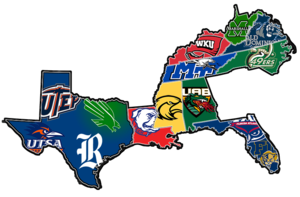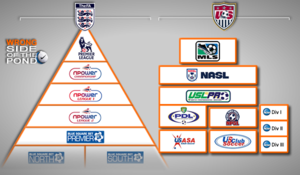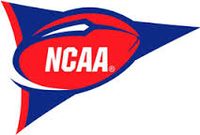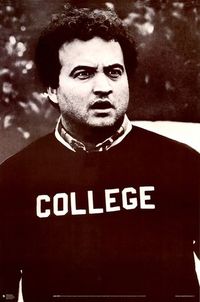
Didn't know? No one else does, either.
That's because Conference USA, where the Owls play these days, isn't considered a “major” conference. It's a “mid-major” conference, thus beneath contempt.
For the last several years, a host of schools have been moving between conferences, and among conferences, based on the size of their alumni, the power of their football teams, and the school's willingness to spend money in order to find a “better” home.
The system enriches only football coaches, and ex-football coaches. It's one of the biggest scams going. The players often get nothing (some get a decent education, if they apply themselves and the coach doesn't fire them for poor play), and the schools are also left destitute. Only a few dozen schools actually profit from football, and they plow the money into athletic facilities, enriching coaches in minor sports.
The system is broken. Time to fix it.

How might that work in the USA? Pretty simply.
Take Rice. We play a collection of schools mostly to our East. Other schools in our region play in leagues that are rated both higher and lower. Generally the Sun Belt is considered a lower league and the new American Athletic Conference, to which most of Rice's former rivals bolted this year, is considered a higher league.
But the AAC isn't a “top” league, and after it loses its automatic BCS bowl bid next year its fate is uncertain. Only five leagues are considered “superior” – the ACC, the Big Ten (which has 12 teams), the Big Twelve (which has 10 teams), the SEC, and the Pac 10 (which also has 12 teams.) The rules state that if you have 12 teams in a league, or more, you can have a money-spinning “conference title” game between the two best teams.
So here goes. The SEC is no longer the Southeastern Conference. It's a national conference. We'll call that the “top flight,” which is simply reality, and give them 16 teams.
We'll define the next four leagues, by regions, as “championship” level conferences. At the end of each season, each will drop one of its teams down a level.
That leaves four spots for the AAC and Mountain West to grab from. But each of them would drop two teams of their own. Those schools would play in Conference USA or the Western Athletic Conference. Those schools, in turn would drop four for the Sun Belt and Big West leagues.

All the championship games, including the national championship playoff, are run by the NCAA, and the profits from those games are spread out among all NCAA members, as they are in lower divisions of football.
The coaches will scream, and the athletic directors are scream, but what do you expect from men who have been scamming the system for decades and don't want to lose out on a good thing? All the current “bowl” games become play-offs within the divisions.
Some fans will scream too. Schools like Mississippi and Vanderbilt might drop a rung or two. But they'd be fighting for titles, instead of mere relevance. Coaches who can bring schools up multiple rungs will earn their fame.

I don't want to hear it can't be done. I want to hear if this makes sense. I think it makes great economic sense, and might result in some of the money from athletics actually flowing to academics, which is where such money belongs.
Oh, and for each year a recruited player plays, they get a full year of college, free, to be completed whenever they want it. Play four years, you will get a college degree, on your schedule, and not the coach's. If the coach wants to “blow you out” for non-performance, they can negotiate a settlement with you, meaning you'll probably get the full four year ride even if you blow out a knee as a freshman.
Now, any other problems I can solve?











wow great idea and good for career players
wow great idea and good for career players
wow
wow
great information.
great information.
This can work in African colleges too, practical idea this is
This can work in African colleges too, practical idea this is
Great piece of information. We nee to start practicing this in Africa.
Great piece of information. We nee to start practicing this in Africa.
Very informative!
Very informative!
Football,the mother of all sports.
Football,the mother of all sports.
Great Read
Great Read
Awesome idea that can be replicated in African countries
Awesome idea that can be replicated in African countries
brilliant
brilliant
Very Educative
Very Educative
its high time football players were offered an insurance through college scholarship so as be a assured of a life after football
its high time football players were offered an insurance through college scholarship so as be a assured of a life after football
Do you think that players could benefit from a Deep Muscle Stimulator such as this? Would be very interesting to see how it would help them?
Do you think that players could benefit from a Deep Muscle Stimulator such as this? Would be very interesting to see how it would help them?
Try to find the most update EPL news , LA LIGA Stories, Italian League ! Do you have any suggestion?
Try to find the most update EPL news , LA LIGA Stories, Italian League ! Do you have any suggestion?
You seem to have found a good one, Justin. Anyone interested in the Championship should click that link you offered. Thanks!
You seem to have found a good one, Justin. Anyone interested in the Championship should click that link you offered. Thanks!
This system is SO broken and continues to be broken today. You are completely right.
This system is SO broken and continues to be broken today. You are completely right.
How is the great information
How is the great information
Dont forget about all that athletic apparel partnership money! Adidas, Nike, etc are all in on it too. The money indeed flows the wrong way. I like your idea about getting kids full-rides on their own schedule. But curious where you stand on simply routing some of the money to the players? Minor league players get paid after-all.
Dont forget about all that athletic apparel partnership money! Adidas, Nike, etc are all in on it too. The money indeed flows the wrong way. I like your idea about getting kids full-rides on their own schedule. But curious where you stand on simply routing some of the money to the players? Minor league players get paid after-all.
I have to say it’s how we provide our services!
https://staysuptodate.wordpress.com/rank-1-on-google/?preview=true
I have to say it’s how we provide our services!
https://staysuptodate.wordpress.com/rank-1-on-google/?preview=true
Really sharing a amazing a Good information i love this gtten
Really sharing a amazing a Good information i love this gtten
It is really good to read all details about Solving College Football. MY brother is a big an of football and i will share this article with him after my https://www.goldenbustours.com/yellowstone-guided-tours/
It is really good to read all details about Solving College Football. MY brother is a big an of football and i will share this article with him after my https://www.goldenbustours.com/yellowstone-guided-tours/
It is really good to read all details about Solving College Football.
It is really good to read all details about Solving College Football.
The 2019 CONCACAF Champions League (officially
the 2019 Scotiabank concacaf champions league for sponsorship reasons) will be
the 11th edition of the CONCACAF Champions League under its current name
https://theconcacafchampionsleague.com/
The 2019 CONCACAF Champions League (officially
the 2019 Scotiabank concacaf champions league for sponsorship reasons) will be
the 11th edition of the CONCACAF Champions League under its current name
https://theconcacafchampionsleague.com/
Has raised so many athletes.
Has raised so many athletes.
Good piece others should emulate
Good piece others should emulate
Great post! Especially I like this blog. Because I have got more informative information from this blog. There are popular sites for solving College Football. Totosite“>https://www.totositegorilla.com>Totosite
Great post! Especially I like this blog. Because I have got more informative information from this blog. There are popular sites for solving College Football. Totosite“>https://www.totositegorilla.com>Totosite